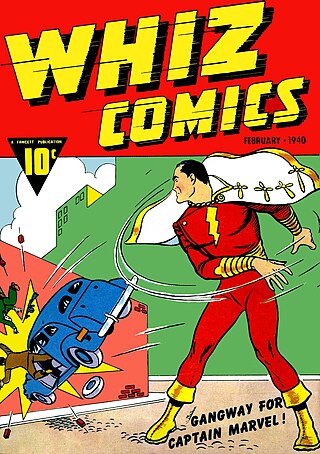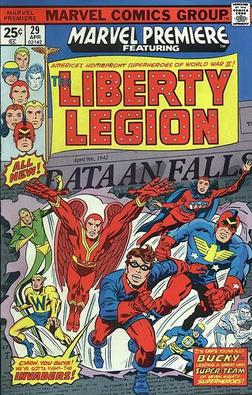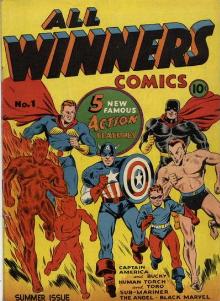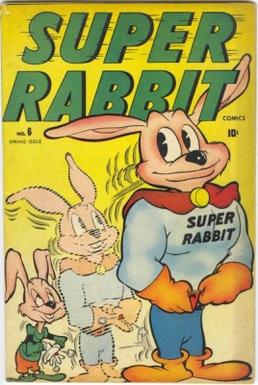
A superhero or superheroine is a stock character who typically possesses superpowers or abilities beyond those of ordinary people, is frequently costumed concealing their identity, and fits the role of the hero; typically using their powers to help the world become a better place, or dedicating themselves to protecting the public and fighting crime. Superhero fiction is the genre of fiction that is centered on such characters, especially, since the 1930s, in American comic books, as well as in Japanese media.

Timely Comics is the common name for the group of corporations that was the earliest comic book arm of American publisher Martin Goodman, and the entity that would evolve by the 1960s to become Marvel Comics.

The Invaders is the name of two fictional superhero teams appearing in American comic books published by Marvel Comics.

Black Widow is a character appearing in American comic books published by Marvel Comics. Created by writer George Kapitan and artist Harry Sahle, the character first appeared in Mystic Comics #4, published by Marvel predecessor Timely Comics. Claire Voyant is a medium who has been murdered and became the demonic "ambassador" of Satan on Earth. She kills evildoers in order to deliver their souls to her master.

All Select Comics is a 1943–1945 American comic book series published by Timely Comics, the 1940s predecessor of Marvel Comics, during the period fans and historians call the Golden Age of comic books. An omnibus series with several different superhero and other features each issue, it primarily starred Captain America and the original Human Torch, two of Timely's most popular characters, as well as fellow Timely star the Sub-Mariner in several.

Vision (Aarkus) is a fictional character, a superhero appearing in American comic books published by Marvel Comics. Created by the writer Joe Simon and artist Jack Kirby, the character first appeared during the Golden Age of comic books in Marvel Mystery Comics #13, published by Marvel predecessor Timely Comics.

The All-Winners Squad is a fictional superhero team appearing in American comic books published by Marvel Comics. The company's first such team, it first appeared in All Winners Comics #19, published by Marvel predecessor Timely Comics during the period fans and historians call the Golden Age of Comic Books.

Vincent Alascia, also known as Nicholas Alascia, was an American comic book artist known for his work on Captain America during the Golden Age of comics, and for his 23-year run as inker on a single creative team, with penciler Charles Nicholas Wojtkowski and writer Joe Gill at Charlton Comics from 1953 to 1976.

The Blonde Phantom is a fictional masked crime fighter appearing in American comic books published by Marvel Comics. Created for Marvel predecessor Timely Comics by Stan Lee and Syd Shores, the character first appeared in All Select Comics #11, during the 1940s period fans and historians call the Golden Age of Comic Books. The heroine was so well received that the next issue was retitled The Blonde Phantom. The series continued to feature her until issue #22. She also appeared in backup stories in many other Timely comics; in Superhero Comics of the Golden Age, Mike Benton observes that "for a few months in 1948, readers could find her in seven titles on the newsstand." In The Supergirls, Mike Madrid asserted, "Once again, a capable woman hid behind a meek persona and only let her hair down, literally, to come to the aid of a man who completely ignored her unless she assumed a disguise. In a 1947 story entitled "I Hate Myself", Louise even dreams that Mark finally confesses his love for her, only to have the Blonde Phantom persona appear and steal him away."

The Liberty Legion is a fictional superhero team appearing in American comic books published by Marvel Comics. The team was first created in 1976 and set during World War II. Composed of existing heroes from Marvel's 1940s Golden Age of Comic Books predecessor, Timely Comics, the team was assembled and named by writer Roy Thomas in a story arc running through The Invaders #5–6 and Marvel Premiere #29–30. Inspired by the Liberty Legion, a second fictional team called the Liberteens was published in 2007 as part of the Avengers Initiative.

Blue Diamond is a fictional superhero appearing in American comic books published by Marvel Comics, debuting under the company's 1940s forerunner, Timely Comics. The character was created in 1941 by Ben Thompson, who also drew the first comic book adventures of Ka-Zar the Great and Citizen V for Timely, as well as the Masked Marvel for Centaur Publications and Dr. Frost for Prize Comics.

All Winners Comics was the name of two American comic book series of the 1940s, both published by Marvel Comics' predecessor, Timely Comics, during the period fans and historians call the Golden Age of Comic Books. A superhero anthology comic in both cases, they variously featured such star characters as Captain America, the original Human Torch, and the Sub-Mariner. All Winners Comics was also the venue for two full-length stories of Marvel's first superhero team, the (hyphenated) All-Winners Squad.
Alfred J. Gabriele was an American comic book artist during the 1940s period fans and historians call the Golden Age of comic books. He was known for his work on some of Marvel Comics' earliest Captain America and Sub-Mariner stories, and for co-creating the company's superheroes Black Marvel, Miss America, and possibly, the Whizzer.

The Woman in Red is a fictional character that first appeared in the period known to comic book historians as the Golden Age of Comic Books. Created by writer Richard E. Hughes and artist George Mandel, she first appeared in Thrilling Comics #2, published by Nedor Comics. The character was later revived by writer Alan Moore for America's Best Comics. She would also be used by Dynamite Entertainment in Project Superpowers Chapter Two.

U.S.A. Comics was an American comic-book series published by Marvel Comics' 1930–1940s predecessor, Timely Comics, during the period fans and historians call the Golden Age of comic books.

Super Rabbit is a talking animal superhero in american comic books published by Timely Comics, a predecessor of Marvel Comics, during the 1930s and 1940s period fans and historians call the Golden Age of comic books. Created by cartoonist Ernie Hart, he first appeared in Comedy Comics #14.

The Whizzer is a superhero appearing in American comic books published by Marvel Comics. He first appeared during the period called the Golden Age of Comic Books.

The Destroyer is the name of three fictional superheroes appearing in American comic books published by Marvel Comics. The original incarnation was created by writer Stan Lee and artist Jack Binder and first appeared in Mystic Comics #6, being one of Lee's earliest creations during the Golden Age of Comic Books.

America Chavez is a superhero appearing in American comic books published by Marvel Comics. Created by writer Joe Casey and artist Nick Dragotta, the character first appeared in Vengeance #1. America Chavez is a lesbian superhero of Latin-American origin. She has assumed the mantle of Miss America from the superheroine Madeline Joyce. She has also been a member of the A-Force, the Ultimates, and the Young Avengers at various points in her history.

Miss America is the name of several superheroines appearing in American comic books published by Marvel Comics. The first incarnation of Miss America, Madeline Joyce, first appeared in Marvel Mystery Comics #49. The second incarnation, Erika Kelley, debuted in Avengers: The Initiative Annual #1. The third incarnation, America Chavez, made her first appearance in Vengeance #1.




















